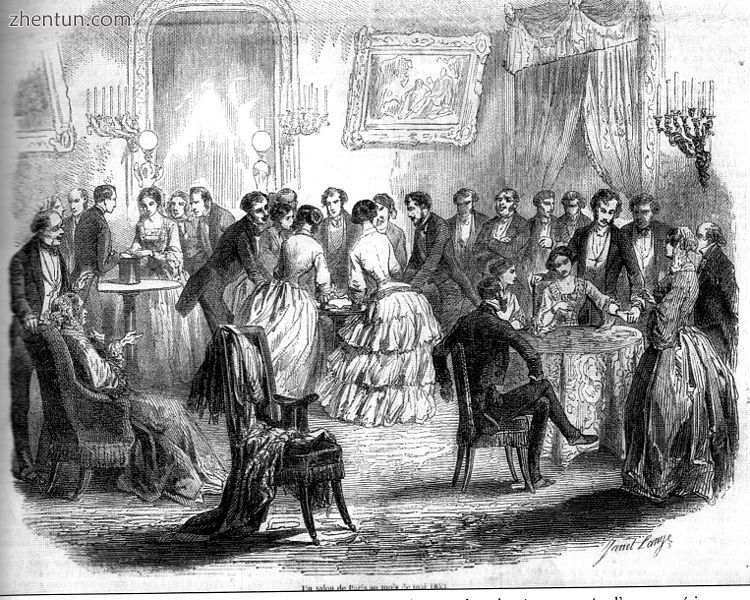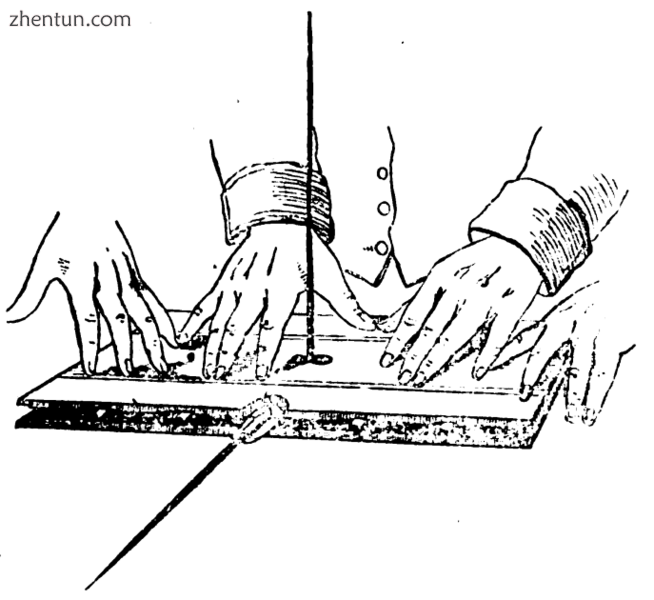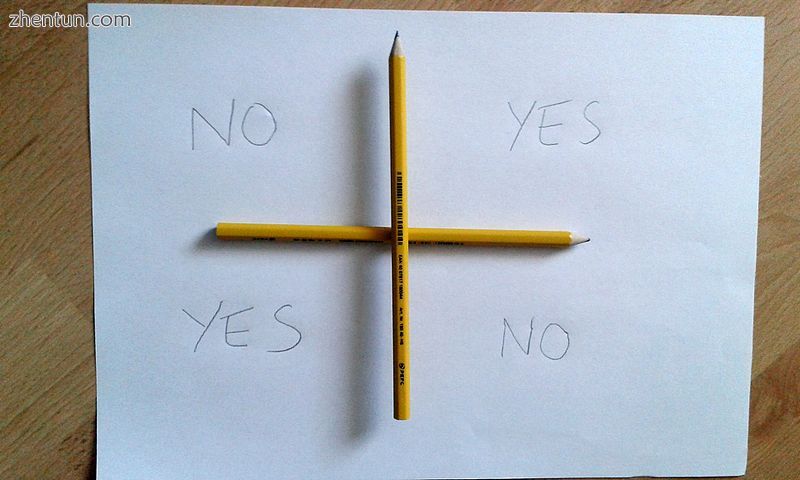意识运动现象是一种心理现象,其中主体在无意识中进行动作。

19世纪法国翻桌子的一个例子。一圈参与者用手按住桌子,这种理想运动效应使桌子倾斜,从而产生书面信息,其方式类似于印象板。

法拉第旋转台理想电机效应实验演示装置
意向运动反应(或意向运动反射),通常缩写为IMR,是催眠和心理学研究中的一个概念。[1]它来源于术语“意向”(意念,或心理表征)和“运动”(肌肉动作)。这个短语最常用于指一种思维或心理意象导致一种看似“自反的”或自动的肌肉反应,通常程度很小,可能超出了主体的意识范围。如同对疼痛的反射性反应,身体有时会以意识形态运动效应对思想作出反射性反应,而无需人有意识地决定采取行动。自动书写、打探、方便通信和Ouija板的效果都归因于这种现象。
相关术语“意念动力反应”(或“反射”)适用于更广泛的领域,并扩展到对由某些想法以类似方式引起的所有身体反应(包括意念运动和意念感觉反应)的描述,例如通常由想象吮吸柠檬引起的流涎,这是一种分泌反应。理想动力反应的概念促成了詹姆斯·布莱德对暗示在催眠中的作用原理的第一个神经心理学解释。
目录
1 科学调查的历史
2 使用
2.1 回答问题
3 参考
科学调查的历史

Charlie Charlie的挑战依赖于意识运动现象来产生其参与者提供的问题的答案 - 来自参与者的呼吸预期结果导致顶部铅笔朝着答案旋转。
随着19世纪40年代灵性主义的兴起,媒体设计并改进了各种技术,表面上是与精神世界进行交流,包括翻转和计划书写板(后来的Ouija板的前身)。这些现象和装置很快成为科学研究的主题。[3] [4]
Ideomotor一词最初用于科学论文,讨论这些灵性现象产生的手段,威廉本杰明卡彭特于1852年,[5]因此替代术语卡彭特效应。 (Carpenter从成分ideo中导出了ideomotor一词,意思是“想法”或“心理表征”,而运动,意思是“肌肉行为”)。在论文中,卡彭特解释了他的理论,即肌肉运动可以独立于有意识的欲望或情绪。
Carpenter是现代催眠术创始人James Braid的朋友和合作者。 Braid很快采用了Carpenter的意识 - 运动术语,以便根据他的老师哲学家Thomas Brown的观点传达他最基本的观点,催眠暗示的效果取决于主体对一个人的集中(因此,“占主导地位的想法。 1855年,Braid解释了他决定放弃他的早期术语“单声道运动”,基于Carpenter(1852)的“意识 - 运动原理”,并采用更合适和更具描述性的术语“单一意识动态”。他的决定是基于他们的共同朋友丹尼尔·诺布尔向卡彭特(1854年)提出的建议,即卡彭特所描述的活动将在更广泛的应用中更准确地理解(即,比钟摆和ouija板更宽)它是以“意识 - 动态原则”命名的:[6]
为了让我可以完全公正地对待两个受人尊敬的朋友,我要求说,就像单音动态这个术语而言,几年前,WB Carpenter博士介绍了意识运动一词,以表征反射或自动肌肉只是从与思想中存在的运动相关的思想产生的动作,没有任何意志的意志努力。在1853年,丹尼尔·诺布尔在谈到这个术语时说:“思想动态可能构成一种更合适的措辞,适用于更广泛的现象。”在这种观点中,我非常同意,因为我很清楚,一个想法可以自动逮捕和激动,不仅在自主运动的肌肉,而且在身体的每个其他功能的状态。因此,我已经采用了单视频动态这个术语,因为在所有发生的动态变化,身体的其他所有功能以及自愿的肌肉中存在的真实的心理关系,它仍然更加全面和有特色的运动。[7]
英国科学家迈克尔·法拉第,曼彻斯特外科医生詹姆斯·布瑞德,[8]法国化学家米歇尔·尤金·切夫勒和美国心理学家威廉·詹姆斯和雷·海曼的科学测试表明,许多现象归因于精神或超自然力量,或神秘的“能量” “,实际上是由于运动行为。此外,这些测试表明,“诚实,聪明的人可以无意识地参与符合他们期望的肌肉活动”。[9]他们还表明,可以通过微妙的线索给出可以指导行为的建议(Hyman 1977)。
一些操作者声称使用感觉运动反应与受试者的“无意识心灵”进行交流,使用物理信号系统(如手指运动),使无意识的头脑表示“是”,“否”,“我不知道”,或“我不准备有意识地知道”。[10]
一个简单的实验证明了运动效果是允许手持摆锤悬停在一张纸上。 该论文上印有YES,NO和MAYBE等关键词。 在回答问题时,手中的小动作会导致钟摆朝向纸上的关键词移动。 该技术已被用于超感知,谎言检测和ouija板的实验。 这种类型的实验被Kreskin [11]使用,并且也被Derren Brown等幻觉学家使用。[12]
用途
回答问题
它与基于“揭露技术”的分析催眠术的实践密切相关,如Watkins的“影响桥”,[13]其中主题为“是”,“否”,“我不知道”,或“我 不想回答“对运营商的问题的回答是通过物理运动而不是语言信号来表示的; 并且是根据预先确定的(在操作者和受试者之间)和预先校准的一组反应的媒介产生的。[14]
另见
Adaptive unconscious
Alien hand syndrome
Automatic writing
Bicameralism (psychology)
Body language
Divided consciousness
Dowsing
Dual consciousness
Facilitated communication
Illusions of self-motion
Left brain interpreter
Ouija
Petrichor
Planchette
Proprioception
Subconscious
Table-turning
Unconscious communication
Unconscious mind
脚注
Shin, Yun Kyoung. "A review of contemporary ideomotor theory". PsycNET. American Psychological Association. Retrieved 5 April 2015.
Heap, Michael. (2002). Ideomotor Effect (the Ouija Board Effect). In Michael Shermer. The Skeptic Encyclopedia of Pseudoscience. ABC-CLIO. pp. 127-129. ISBN 1-57607-654-7
Planchette; or, The Despair of Science. Boston: Roberts Brothers. 1869. pp. 1–20. Retrieved 2014-02-18.
Anderson, John Henry (1885). The Fashionable Science of Parlour Magic. p. 85. Retrieved 2015-02-18.
William Benjamin Carpenter (March 12, 1852). "On the influence of Suggestion in Modifying and directing Muscular Movement, independently of Volition". Retrieved 2010-02-27.
Noble (1854), Lecture III, p.642.
Braid, (1855), footnote at p.10.
See, for example, Braid's letter to Michael Faraday (22 August 1853).
Ray Hyman (1999). "The Mischief-Making of Ideomotor Action" (reproduced on web as How People Are Fooled by Ideomotor Action). The Scientific Review of Alternative Medicine (Fall–Winter). Retrieved 2006-09-07.
Cheek (1962).
http://www.1stingames.com/rules/kreskinsesp/index.pdf see how kreskin used this pendulum
Brown, Derren. (2007). Tricks of the Mind. Transworld Publishers. p. 48. ISBN 978-1905026357
Watkins, (January 1971).
LeCron, (1954).
参考
Anderson, J.W., "Defensive Maneuvers In Two Incidents Involving The Chevreul Pendulum: A Clinical Note", International Journal of Clinical and Experimental Hypnosis, Vol.XXV, No.1, (1977), pp. 4–6.
Braid, J., "Mysterious Table Moving", The Manchester Examiner and Times, Vol.5, No.469, (Saturday, 30 April 1853), p. 5, col.B.
Braid, J., Hypnotic Therapeutics, Illustrated by Cases: With an Appendix on Table-Moving and Spirit-Rapping. Reprinted from the Monthly Journal of Medical Science for July 1853, Murray and Gibbs, (Edinburgh), 1853.
Braid, J., "Letter to Michael Faraday on the phenomenon of "Table Turning" [written on 22 August 1853]", reprinted at pp.560-561 of James, F.A.J.L., The Correspondence of Michael Faraday, Volume 4: January 1849 - October 1855, Institution of Electrical Engineers, (London), 1999.
Braid, J., The Physiology of Fascination, and the Critics Criticised, John Murray, (Manchester), 1855.
Carpenter, W.B., "On the Influence of Suggestion in Modifying and directing Muscular Movement, independently of Volition", Royal Institution of Great Britain, (Proceedings), 1852, (12 March 1852), pp. 147–153.
Carroll, R.T., "Ideomotor effect". The Skeptic's Dictionary. 2003. ISBN 0-471-27242-6
Cheek, D.B., "Some Applications of Hypnosis and Ideomotor Questioning Methods for Analysis and Therapy in Medicine", American Journal of Clinical Hypnosis, Vol.5, No.2, (October 1962), pp. 92–104.
Cheuvrel. Michel E., De la Baguette Divinatoire et du Pendule Dit Explorateur (On the Divining Rod and the So-called Exploratory Pendulum), Maillet-Bachelier, Paris, 1854.
Easton, Randolph D.; Shor, Ronald E. (1976). "An Experimental Analysis of the Chevreul Pendulum Illusion". The Journal of General Psychology. 95 (1st Half): 111–25. doi:10.1080/00221309.1976.9710871. PMID 956790.
Easton, Randolph D.; Shor, Ronald E. (1977). "Augmented and Delayed Feedback in the Chevreul Pendulum Illusion". The Journal of General Psychology. 97 (2): 167. doi:10.1080/00221309.1977.9920835.
Easton, Randolph D.; Shor, Ronald E. (1975). "Information processing analysis of the Chevreul pendulum illusion". Journal of Experimental Psychology: Human Perception and Performance. 1 (3): 231. doi:10.1037/0096-1523.1.3.231.
Erickson, Milton H. (1961). "Historical Note on the Hand Levitation and other Ideomotor Techniques". American Journal of Clinical Hypnosis. 3 (3): 196. doi:10.1080/00029157.1961.10701715.
Faraday, M., "Experimental Investigation of Table-Moving", Athenaeum, No.1340, (July 1853), pp. 801–803.
Faraday, M., "Table-Turning", The Times, No.21468, (30 June 1853), p. 8.
Le Baron, George I. (1962). "Ideomotor Signalling in Brief Psychotherapy". American Journal of Clinical Hypnosis. 5 (2): 81. doi:10.1080/00029157.1962.10402270.
LeCron, L., "A Hypnotic Technique for Uncovering Unconscious Material", Journal of Clinical and Experimental Hypnosis, Vol.II, No.1, (January 1954), pp. 76–79. doi=10.10.1080/00207145408409936
Montgomery, Guy; Kirsch, Irving (1996). "The Effects of Subject Arm Position and Initial Experience on Chevreul Pendulum Responses". American Journal of Clinical Hypnosis. 38 (3): 185–90. doi:10.1080/00029157.1996.10403336. PMID 8712161.
Noble, D., "Three Lectures on the Correlation of Psychology and Physiology: I. General Remarks on the Physiology of the Brain and Nervous System, etc.", Association Medical Journal, Vol.3, No.79, (7 July 1854), p.586-588; "II. Of Emotional Sensibility, and its Reactions", No.80, (14 July 1854), p.615-616; "III. On Ideas, and Their Dynamic Influence ", No.81, (21 July 1854), p.642-646.
Randi, J., "Ideomotor effect". An Encyclopedia of Claims, Frauds, and Hoaxes of the Occult and Supernatural. 1995. ISBN 0-312-15119-5
Reed, H. B. (1914). "Ideo-Motor Action". The Journal of Philosophy, Psychology and Scientific Methods. 11 (18): 477–91. doi:10.2307/2013141. JSTOR 2013141.
Shenefelt, Philip D., "Ideomotor Signaling: From Divining Spiritual Messages to Discerning Subconscious Answers during Hypnosis and Hypnoanalysis, a Historical Perspective", American Journal of Clinical Hypnosis, Vol.53, No.3, (January 2011), pp.157-167.
Spitz, H.H. & Marcuard, Y., "Chevreul's Report on the Mysterious Oscillations of the Hand-Held Pendulum: A French Chemist's 1833 Open Letter to Ampère", The Skeptical Inquirer, (July/August 2001) Vol.25, No.4, pp. 35–39.
Stock, Armin; Stock, Claudia (2004). "A short history of ideo-motor action". Psychological Research. 68 (2–3): 176–88. doi:10.1007/s00426-003-0154-5. PMID 14685855.
Sudduth, W.X., "Suggestion as an Ideo-Dynamic Force", pp. 255–262 in Anon, Bulletin of the Medico-Legal Congress: Held at the Federal Building in the City of New York, September 4, 5th, and 6th, 1895, Medico-Legal Journal for Medico-Legal Society, (New York), 1895.
Watkins, J.G., "The Affect Bridge: A Hypnoanalytic Technique", The International Journal of Clinical and Experimental Hypnosis, Vol.19, No.1, (January 1971), pp. 21–27. doi=10.1080/00207147108407148
Yeates, L.B., James Braid: Surgeon, Gentleman Scientist, and Hypnotist, Ph.D. Dissertation, School of History and Philosophy of Science, Faculty of Arts & Social Sciences, University of New South Wales, January 2013. |